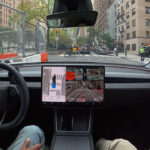The quietness of electric vehicles (EVs) means artificial sounds are necessary for safety. Pedestrians, animals, and other drivers benefit from when EVs are louder driving down the street.
The need for artificial noise has led electric car manufacturers and owners to look to Tesla for inspiration. Should Tesla’s pedestrian warning system (PWS) be the standard?
Tesla introduced the PWS in 2019, starting with the Model 3. Then, the electric car manufacturer allowed owners with older Model 3s and Ys to retrofit their vehicles with speakers and comply with regulations.
The federal government has gradually become stricter with EV noise requirements as Teslas and other EVs become more commonplace. For instance, the Pedestrian Safety Enhancement Act of 2010 published standards for vehicles alerting pedestrians.

Tesla’s warning device positioned the automaker as one of the first with such a system. The vehicle emits sound while operating under 19 mph and in reverse gear. Tesla vehicles get louder the faster the driver goes, alerting those nearby of their presence.
How loud do Teslas need to be? The National Highway Traffic Safety Administration (NHTSA) says EVs must be 56 decibels (dB) or higher for pedestrian safety. The noise from Teslas comes from its speakers and is most detectable when in front of the vehicle. While quieter behind or beside, pedestrians can still hear it from a safe distance.
Tesla was among the first with a PWS. Other manufacturers have since introduced their own devices. Ford, BMW, Honda, and other automakers have followed Tesla and NHTSA by installing these warning sounds in their hybrids and battery-electric vehicles (BEVs).
Extended time in the industry makes Tesla’s PWS stand amongst the manufacturers. The company’s researchers have had more time to work out the bugs, leading to more well-rounded devices. Tesla owners used to modify their PWS, but NHTSA regulations standardized the noise to ensure all drivers use the same one.

The Pedestrian Warning System causes Model 3 to emit sound when driving below approximately 40 km/h or while driving in reverse. Electric vehicles operate quietly and this sound helps to alert pedestrians of your oncoming vehicle. The sound, which activates whenever Model 3/Y/S/X is shifted out of Park, gets louder as speed increases.
Source: Tesla Owner’s Manual
While effective, Tesla says drivers should not rely solely on the PWS to alert others. Those who do may increase the chances of a collision, possibly causing severe harm.
The PWS also must reckon with recent scrutiny from regulators. Tesla recalled over 6,500 vehicles because the warning mechanism malfunctioned. An investigation revealed the PWS did not meet safety standards after a factory reset.
Tesla discovered an issue with a vehicle within the company’s fleet, with a muted PWS concerning operators. The problem stemmed from the infotainment processor after updating to software version 2023.32. Despite a reset, the PWS still did not work. Tesla’s recall says the malfunctioning PWS affected most models, especially the Model 3.
The March 2024 report was not the only issue Tesla has faced with the PWS. In 2022, the automaker announced a wider recall affecting 579,000 vehicles and their PWS systems. The NHTSA said Tesla’s Boombox software obscured the PWS, thus violating guidelines on manufactured noise.
The need for robust warning systems becomes more urgent as pedestrians feel less safe. Research shows on average 430 pedestrians are injured by oncoming traffic each day in the U.S., with the number of deaths increasing to over 7,500 in 2022.
Tesla’s PWS should be the standard for the automotive industry because of the company’s experience and dedication to EVs. The automaker has exclusively sold BEVs for nearly two decades and leads the sector in these technologies. Other manufacturers have closed the gap, but Tesla leads the way for now.
While the PWS satisfies the NHTSA and customers, more development is necessary for pedestrian safety. Society has rapidly gravitated toward smartphones, with 90% of Americans owning a device for work or personal use. Smartphones are helpful but can be distracting for pedestrians.
What’s the next step for EVs? Researchers say it’s advanced technology like vehicle-to-everything (V2X) connections. A Transportation Research Procedia study says a PWS might not be enough if pedestrians wear headphones or have devices with distracting sounds.
Therefore, V2X protocols are necessary to notify people on the street when vehicles are approaching. The researchers find paused music and customized messages are the most practical ways to alert pedestrians when an EV is coming.
Tesla and other manufacturers will continue improving their PWS as EVs grow their market share. Experts say fully electric cars constituted 8.1% of the automobile market in Q4 of 2023, demonstrating their rise.
Stay tuned for constant Tesla updates, follow us on:
Google News | Flipboard | X (Twitter) | WhatsApp Channel | RSS (Feedly).
Related
- Tesla FSD v14.2.1 conquers ‘The Snake’ highway in California (hairpin turns, ~30 curves, video)
- Tesla FSD v14.2.1 recognizes hand gestures and proceeds a red light and more (videos)
- License Tesla FSD or face the disruption — Musk once again warns legacy automakers
- Tesla offers 30-day FSD v14 trials to HW4 vehicles in North America, FSD v14.2 goes wide release
- Tesla update 2025.44 goes wide with Radio Traffic Announcements, dashcam tweaks, preps for Holiday Update (Release Notes)
- Tesla FSD v14.2 modifies how you select Speed Profiles and Arrival Options







